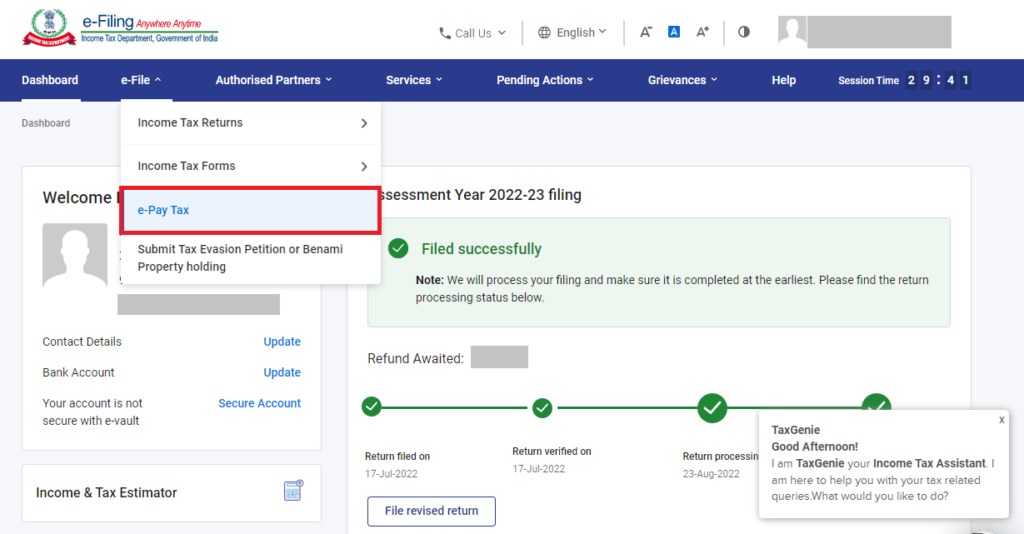When it comes to managing your finances, staying up-to-date with tax payments is crucial. While many people anticipate receiving a refund when filing their income tax return, there are instances where you may owe additional taxes instead. This could happen due to underpayment during the tax year, adjustments in deductions, or changes in income. In such cases, you may need to make additional payments to the Income Tax Department to settle your outstanding balance.
If you’re filing an original ITR, revised ITR, updated income tax return (ITR-U), or a belated return, you might encounter penalties and interest charges. Minor heads may change depending on the payment you are making. For example, If you are paying for some outstanding demand then you might need to choose Regular Assessment tax (400) or if you are paying regular tax then you need to choose self-assessment tax (300). Understanding how to make these payments online is essential for avoiding further complications and ensuring your tax matters are in order.

What is Self Assessment Tax and How to Pay it Online?
Self Assessment Tax is the portion of tax paid by individuals on their taxable income that is not subjected to TDS (Tax Deducted at Source) or Advance Tax payments. It enables taxpayers to reconcile their total income, compute tax liability, and pay any outstanding dues.
To pay Self Assessment Tax online, you can visit the income tax department’s official website, select the appropriate challan, fill in the required details, and make the payment using net banking or debit card options.
Why Should You Pay Self Assessment Tax?
Paying Self Assessment Tax is crucial as it ensures compliance with the tax laws of our country. Failing to pay your due taxes or underpaying it can lead to penalties, interest charges, and legal consequences. It is essential for fulfilling one’s tax obligations honestly and in a timely manner.
Self assessment is one of the easiest ways of filing income tax returns online. You can follow the instructions given on the Income Tax e-filing website to file self-assessment and calculate your outstanding dues by checking Form 26AS or AIS. Furthermore, there is no strict deadline; you have an entire financial year to file your self assessment returns.
Characteristics of Self Assessment Tax
- It is payable by individuals, including salaried employees, freelancers, professionals, and business owners.
- It is calculated on the total income derived from various sources, excluding the amount already subjected to TDS or advance tax payments.
- It is calculated, filed, and paid by taxpayers themselves and not through an employer or other entities.
- It must be paid before the annual income tax return filing deadline.
- It is applicable when your total tax liability exceeds the TDS deducted amount.
- Interest is levied on delayed payment of Self Assessment Tax.
Eligibility for e-Tax Payment
Starting from April 1, 2008, certain taxpayers are required to make their tax payments online. This mandatory requirement includes the following categories of taxpayers:
- All corporate assesses: This includes all companies, regardless of their size or type of business.
- All assesses (other than companies) to whom the provisions of section 44AB of the Income Tax Act, 1961 are applicable: This refers to non-corporate taxpayers who meet the criteria specified in section 44AB of the Income Tax Act, 1961. Section 44AB pertains to the mandatory tax audit requirements for businesses or individuals meeting specific financial thresholds.
Benefits of Income Tax Online Payment
- Convenience: Online payment methods offer a high level of convenience. Taxpayers can make payments from anywhere, anytime, as long as they have an internet connection. This eliminates needing to visit a tax office or mail a physical payment.
- Time-saving: Online payment systems streamline the process, allowing taxpayers to complete their transactions quickly. It eliminates the need for manual paperwork, filling out forms, and waiting in long queues.
- Accuracy: Online payment platforms often have built-in calculators that help taxpayers determine the correct amount of tax owed. This reduces the chances of errors in calculations and ensures accurate payment.
- Instant confirmation: When making an online payment, taxpayers receive immediate confirmation that their payment has been processed. This provides peace of mind and eliminates uncertainty about whether the payment was received and credited.
- Secure transactions: Reputable online payment platforms employ robust security measures to protect users’ financial information. Encryption techniques and secure servers ensure that sensitive data is transmitted and stored safely.
- Reminder notifications: Some online payment platforms offer reminder services, sending notifications to taxpayers when payment deadlines are approaching. This helps taxpayers stay organized and avoid late payment penalties.
- Verification: By visiting the website of the Tax Information Network, you can verify if the IT department has received the payment or not.
Documents required for paying Income Tax Online Form 16
- Form 16
- Salary slips and bank statement
- Form 16A, Form 16 B, or Form 16C
- Interest certificates issued by bank or post office
- Form 26AS
- Tax saving investment proof
- Aadhaar Card
- PAN Card
- Home loan statement
- Capital gain Statement
How to e-Pay Income Tax Online?
Step 1: To begin, go to the official Income Tax portal at https://www.incometax.gov.in/iec/foportal/. Then, find and select “e-Pay Tax” from the menu on the left side of the screen
Step 2: Enter the PAN/TAN details along with your mobile number. (If you’re making the payment on someone else’s behalf, use their PAN number; however, you can input your mobile number regardless of the payer). Subsequently, you’ll receive a One-Time Password (OTP) on your registered mobile number. Enter the OTP and proceed by clicking ‘continue.’
Step 3: Once you’ve entered the OTP, a new page will appear confirming the successful verification of your mobile number. Proceed by clicking the ‘continue’ button.
Step 4: On this page, you’ll find multiple payment options available. If you’re making an income tax payment such as advance tax or additional tax, locate the first payment box labeled ‘Income Tax’ and click on the proceed button.
Step 5: Choose the assessment year and your payment type from the drop-down menu. If you’re paying additional tax, interest, or a penalty for late ITR filing, select “Self-Assessment Tax (300)” and then click on ‘Continue.’
Step 6: Fill the payment amount correctly under the relevant categories.
Step 7: Choose your preferred payment method and bank to process the tax payment, then click on ‘Continue’.
You can choose internet banking, debit card, credit card, RTGS/NEFT, UPI, or opt to pay at the bank counter.
Step 8: Upon clicking ‘Continue,’ you’ll be able to review the payment details. Ensure the payment information is accurate and Click ‘Pay Now’ to proceed with the payment, or select ‘Edit’ to make any necessary changes.
Step 9: Mark the checkbox to agree to the Terms and Conditions and proceed with the payment by clicking on ‘Submit To Bank’.
Step 10: Upon successful submission of your tax payment, you will receive a confirmation.
FAQs
Is it mandatory to pay tax online?
Online income tax payment is mandatory for all companies and all non-corporate taxpayers covered in audit under section 44AB. Apart from these, all other taxpayers can also pay their taxes offline after downloading challan 280 and submitting it to a bank, as mentioned in the above section.
I need to find my counterfoil. What should I do?
Banks provide online facilities for the regeneration of challan on their website in case the counterfoil is misplaced.
Practice area's of B K Goyal & Co LLP
Income Tax Return Filing | Income Tax Appeal | Income Tax Notice | GST Registration | GST Return Filing | FSSAI Registration | Company Registration | Company Audit | Company Annual Compliance | Income Tax Audit | Nidhi Company Registration| LLP Registration | Accounting in India | NGO Registration | NGO Audit | ESG | BRSR | Private Security Agency | Udyam Registration | Trademark Registration | Copyright Registration | Patent Registration | Import Export Code | Forensic Accounting and Fraud Detection | Section 8 Company | Foreign Company | 80G and 12A Certificate | FCRA Registration |DGGI Cases | Scrutiny Cases | Income Escapement Cases | Search & Seizure | CIT Appeal | ITAT Appeal | Auditors | Internal Audit | Financial Audit | Process Audit | IEC Code | CA Certification | Income Tax Demand Notice | Psara License | FCRA Online
Most read resources
tnreginet |rajssp | jharsewa | picme | pmkisan | webland | bonafide certificate | rent agreement format | tax audit applicability | 7/12 online maharasthra | kerala psc registration | antyodaya saral portal | appointment letter format | GST Search Taxpayer | caro 2020 | Challan 280 | itr intimation password | internal audit applicability | preliminiary expenses | mAadhar | e shram card | ec tamilnadu | aaple sarkar portal | epf activation | scrap business | brsr | depreciation on computer | west bengal land registration | traces portal | Directorate general of GST Intelligence | form 16 | rtps | patta chitta
